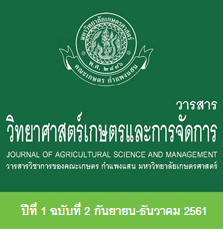Hot Air Drying Treatment for Controlling Tamarind Weevil (Sitophilus linearis (Herbst))
Keywords:
Tamarind Weevil, Sitophilus linearis (Herbst),, heat treatment control, hot dry airAbstract
The objective of this study was to determine the effect of temperature and heating period on the control of sweet tamarind weevil using hot dry air. The experiment was based on the 3x6 factorial in randomized completely block design with 3 replications. The sweet tamarind pods (450 grams) were packed in a box (12.5x20x15 cm.), treated at 3 levels of temperature (60, 70 and 80 °C) and 5 level of heating periods (30, 60, 120, 180 and 240 minutes). After treated, tamarind pods were placed in room temperature, 32 °C. The emerging adults were determined and recorded every two days up to 64 days. It was found that the temperature with the heating period at 60-70 °C in 240 minutes or 80 °C in 120 minutes had a high potential in controlling eggs and larva of tamarind weevil but were less efficiency to control the pupal and adult stage..
References
กรรณิการ์ เพ็งคุ้ม และดวงสมร สุทธิสุทธิ์. 2554. การใช้สารรมฟอสฟีนในการป้องกันแมลงศัตรูมะขามหวานหลังการเก็บเกี่ยว. กลุ่มวิจัยพัฒนาเทคโนโลยีหลังการเก็บเกี่ยว สำนักวิจัยและพัฒนาวิทยาการหลังเก็บเกี่ยวและแปรรูปผลิตผลเกษตร กรมวิชาการเกษตร.กรุงเทพฯ.
ใจทิพย์ อุไรชื่น อัจฉรา เพชรโชติ และพรทิพย์ วิสารทานนท์. 2553. การควบคุมด้วงงวงข้าวโพด Sitophilus zeamais Motschulsky (Coleoptera: Curculionidae) ศัตรูข้าวหลังเก็บเกี่ยว ด้วยการใช้ความร้อน. หน้า 54-64. ใน: เรื่องเต็มการประชุมวิชาการของมหาวิทยาลัยเกษตรศาสตร์ ครั้งที่ 48. มหาวิทยาลัยเกษตรศาสตร์. กรุงเทพฯ.
ชูศักดิ์ สัจจพงษ์. 2554. การปลูกมะขาม. พิมพ์ครั้งที่ 3. กองเกษตรสัมพันธ์ กรมส่งเสริมการเกษตร กรุงเทพฯ. 15 น.
เทพ เพียมะลัง. 2552. รายงานการวิจัยเรื่องการบริหารแมลงศัตรูมะขามหวานตามแนวเศรษฐกิจพอเพียงของกลุ่มวิสาหกิจชุมชนบ้านพลํา อําเภอเมือง จังหวัดเพชรบูรณ์. มหาวิทยาลัยราชภัฏเพชรบูรณ์ จังหวัดเพชรบูรณ์. 65 น.
บรรจง นวลพลับ. 2528. มะขามหวาน. สำนักพิมพ์ฐานเกษตรกรรม. กรุงเทพฯ. 78 น.
ประเสริฐ อนุพันธ์. 2522. มะขามหวาน. วิทยาสารกองพืชสวน 3(3): 87-90.
พรทิพย์ วิสารทานนท์ กุสุมา นวลวัฒน์ บุษรา จันทร์แก้วมณี ใจทิพย์ อุไรชื่น รังสิมา เก่งการพานิช กรรณิการ์ เพ็งคุ้ม และจิราภรณ์ ทองพันธ์ ดวงสมร สุทธิสุทธิ์ ลักขณา ร่มเย็น และภาวินี หนูชนะภัย. 2548. แมลงที่พบในผลิตผลเกษตรและการป้องกันกำจัด. โรงพิมพ์ชุมนุมสหกรณ์การเกษตรแห่ง ประเทศไทย จำกัด, กรุงเทพฯ. 150 น.
เพ็ญจันทร์ สังข์แก้ว จินตนา สนามชัยสกุล และ ชาญชัย สุขสกุล. 2555.การพัฒนารูปแบบการจัดการองค์กรธุรกิจชุมชนเพื่อการพึ่งตนเองตามแนวเศรษฐกิจพอเพียงประเภทธุรกิจ เกษตรของเกษตรกรปลูกมะขามหวานเพื่อการค้า จังหวัด เพชรบูรณ์. ราชภัฏเพชรบูรณ์สาร 12(1): 142-149.
ภาวินี หนูชนะภัย รังสิมาเก่งการพานิช จารุวรรณ์ รัตนสกุลธรรม. 2017. ระดับอุณหภูมิความร้อนในการควบคุมแมลงศัตรูสมุนไพรอบแห้ง. Thai Agricultural Research Journal 35(2): 197-209.
สำนักงานเศรษฐกิจการเกษตร. 2560. ระบบแสดงข้อมูลด้านสถิติ [ออนไลน์]. แหล่งที่มา:http://www.oae.go.th/oae_report/export_import/main.php, 28 มิถุนายน 2560.
Bakker-Arkema, F.W., R.C. Brooker and L.E. Lerew. 1977. Cereal grain drying. Advances in Cereal Science and Technology 2: 1–90.
Beckett, S.J. and R. Morton. 2003. Mortality of Rhyzopertha dominica (F.) (Coleoptera: Bostrychidae) at grain temperatures ranging from 50◦C and 60◦C obtained at different rates of heating in a spouted bed. Journal of Stored Products Research 39(3): 313-332.
Beckett, S.J., R. Morton and J.A. Darby. 1998. The mortality of Rhyzopertha dominica (F.) (Coleoptera: Bostrychidae) and Sitophilus oryzae (L.) (Coleoptera: Curculionidae) at moderate temperatures. Journal of Stored Product Research 34: 363–376.
Cotton, R.T. 1920. Tamarind Pod Borer, Sitophilus linearis (Herbst) Stored-Product Insect Investigations, United States Department of Agriculture, Bureau of Entomology.
Fleurat-Lessard, F. 1985. Les traitements thermiques de désinfestation des céréales et des produits céréaliers: possibilité d’utilisation pratique et domain d’application. Bulletin OEPP 15: 109–118.
Ghaly, T.F. 1981. Heat-damage studies in relation to high temperature disinfestation of wheat. In: Proceedings of the Australian Stored Grain Pest Control Conference, Melbourne, Section 4: 9–12.
Kirkpatrick, R.L. and A. Cagle. 1978. Controlling insects in bulk wheat with infrared radiation. Journal of the Kansas Entomological Society 51: 386–393.
Mbata, G.N. and T.W. Phillips. 2001. Effects of temperature and exposure time on mortality of stored product insects exposed to low pressure. Journal of Economic Entomology 94: 1302-7.
Nelson, S.O. and L.E. Stetson. 1974. Comparative effectiveness of 39 and 2450-MHz electric fields for control of rice weevils in wheat. Journal of Economic Entomology 67: 592– 595.
Ojo, J.A. and A.A. Omoloye. 2015. Life History of the Tamarind Weevil, Sitophilus linearis (Herbst) (Coleoptera: Curculionidae), on Tamarind Seed. Department of Crop Production, Kwara State University, Malete 23431, Kwara State, Nigeria.
Qaisrani, R. and H.J. Banks. 2000. The prospects for heat disinfestation of grain. In Stored Grain in Australia: 2nd Proceedings of the Australian Postharvest Technical Conference, Adelaide, Australia, Canberra, Stored Grain Research Laboratory, CSIRO Entomology: 61-65.
Sutherland, J.W., D.E. Evans, A.G. Fane, and G.R. Thorpe. 1986. Disinfestation of grain with hot air. 261–274. In: Proceedings of the 4th International Working Conference on Stored-product protection. Tel Aviv, Israel.
Winterbottom, D.C. 1922. Weevil in wheat and storage of grain in bags: a record of Australian experience during the war period (1915–1919). Adelaide, Government Printer, 122p.






